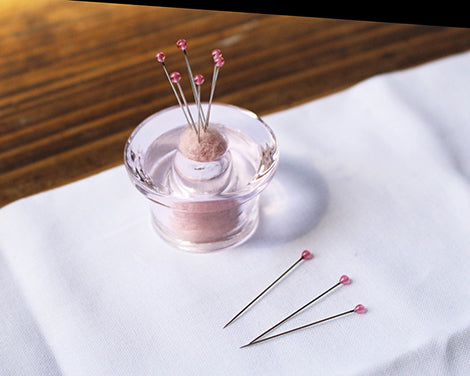A beautiful pincushion set with 10 color-coordinated glass sewing pins.
The glass container is handcrafted in Otaru, Hokkaido by artisans for a one-of-a-kind pincushion in the shape of a plump flowerpot, complete with a matching needlefelted cushion.
Our partners at Fukugawa Glass Kogei specialize in the intricate Kiriko glass-cutting technique that brings out a flower motif of this vibrant glass pincushion.
The cushion itself uses wool from Hokkaido sheep that is dyed and felted by hand at Kokoromoko, a needlefelting studio run by Mari Sugita. The cushion is removable for extra versatility, as the glass container can also be used as a pen holder, catch-all bowl, or jar for sewing notions and tools.
The heads of the pins are blown from the same glass as their container and then affixed to high-quality needles from Hiroshima that pierce cloth with ease.



Pincushion
The pincushion is made up of the top lid and a wool cushion. Make sure to insert the wool cushion entirely to the hole of the lid so that the pincushion can be stabilized.
※Please remove all the sewing pins, before inserting/removing the wool cushion from the pincushion.

Pen holder
The base and the top lid without the wool cushion can be used as a pen holder or a vase for a single flower.
※If you force the pen into the hole, it may cause the damage to the glass.
※If the surface of the glass is stained with ink, wipe it off with a soft cloth.

Single flower vase
The base and the top lid without the wool cushion can be used as a single flower vase.
※If the vase is left filled with water for a long period of time, water stains may form.

Otaru Kiriko Pincushion / Fukagawa Glass Crafts × Wool Felt Studio Kokoromoko
Producing Region : Hokkaido
【Fukagawa Glass Crafts】Otaru, Hokkaido
Fukagawa Glass Kogei was established in Fukagawa-ku, Tokyo in 1964.
They moved Otaru in Hokkaido after losing their factory twice by fire caused Tokyo earthquake and war.
They developed their own tradition as Otaru Kiriko with skills and techniques that they brought from Edo Kiriko.



【Wool Felt Studio Kokoromoko】Sapporo, Hokkaido
Kokoromoko, a studio established by Mari Sugita. She is a wool felt artist making her works in Hokkaido.
She uses the wool felt from the sheep raised in Hokkaido for her art works.
The felt balls for Cohana’s Otaru Kiriko Pincushion are made carefully by hand for people admire have the warmth of the handicrafts.

Product Size
※All measurements are for reference. Please note in advance that the actual dimensions and weight of the product may slightly vary.
※The length of the needle may change slightly due to the welding of glass balls.
| Pincushion | Width:60mm, Height:59mm, Depth:60mm |
| Sewing Pins | Length:33mm, Glass Top Diameter:2mm, Thickness:0.5mm |
Handling Precautions
- Avoid strong contact between the lid and the base. They may be damaged or broken.
- Do not slide the base on the fabric or desk. It may tear the fabric or damage the desk.
- Glass may crack due to sudden temperature changes.
- There is no cover for the bottom of the lid. Be careful for the needle tips coming out of the felt.
- If you put the sewing pins too strong, the felt can come off from the bottom of the lid.
- Place your fingertips lightly on the lid to prevent it from floating when removing a needle or a pin.
- Due to the nature of silicone, yellowing, peeling, and hardening will occur over time.
- Do not wash or soak the base in water. Silicon on the base may come off.
- When cleaning the lid, wash it by hand, use a soft sponge or cloth with a neutral detergent, rinse well with water then dry.
- Avoid using dishwasher, dryer, scrubbing brushes and abrasive sponge cleansers.
- The glass top of the sewing pin may come off if you pull too strong.
- After use, wipe off sweat and grease to prevent rust.
- The needle tip is sharp and dangerous, so be careful when handling lost needles.
- Do not use the pins for anything other than sewing.
- Keep out of reach of infants.